Ancient Corinth was one of the most prominent city-states of Greek antiquity. Located straight after the Isthmus of Corinth -the narrow land bridge connecting the Peloponnese with mainland Greece- the city-state reached a population of more than 90,000 inhabitants back in 400 BC. The archaeological excavations in the area, known as the Corinth Excavations, started in 1896 and continue to this day. They revealed extensive parts of Ancient Corinth together with elements of a fully organized society and, of course, the legendary Temple of Apollo.
I visited Ancient Corinth a couple of months ago and was ecstatic in front of the ruins. The ancient Greek city is well-preserved, and the nearby museum hosts many antiquity gems. While the highlight is undoubtedly the Temple of Apollo, the site is full of impressive monuments and items.
One could actually write forever about Ancient Corinth. However, I believe that first-time visitors would appreciate some useful info instead of a history book. Therefore, in this article, I prefer to write down 10 facts about Ancient Corinth and offer you some tips for visiting this remarkable city-state. You will also see several photos and a video in 4K straight below.
So, let’s start with the guide to Ancient Corinth.
*Some links are affiliate links. It means that if you buy something, I might earn a small commission at no additional cost to you.
10 facts about Ancient Corinth
1. Where is Ancient Corinth located, and how can you reach it?
Ancient Corinth is located in the Peloponnese. If you are starting from Athens, the easiest way to reach it is by car. It’s 70 km away, and it’s an easy one-hour drive through the motorway. Therefore, visiting the ancient city-state of Corinth is an excellent idea for a day trip from Athens.
At the bottom of this post, I will link to some organized tours to Corinth. However, if you have a driving license, it’s much easier to go by car. Check out here the best options for renting a car in Athens, Greece.
2. When did Ancient Corinth exist?
According to neolithic pottery discoveries, the area was inhabited already from 6500 BC. During the Early Bronze Age, the settlement served as a trade center. Progressively, Corinth developed into a powerful city.
It was under the Bacchiadae (747-650 BC) that Corinth expanded its cultural influence. It became a unified state, large buildings emerged, and the first colonies, like Syracuse, were established. For the next couple of centuries, Corinth continued to flourish and expanded its political and cultural presence. Especially after the period of tyrants and during the classical times, Corinth’s wealth could be compared with Athens and Thebes.
The end of the Hellenistic period and the beginning of the Roman era marked the end of Corinth’s glory days. However, the proofs of both civilization and life in Ancient Corinth remain visible.
3. When was Ancient Corinth destroyed?
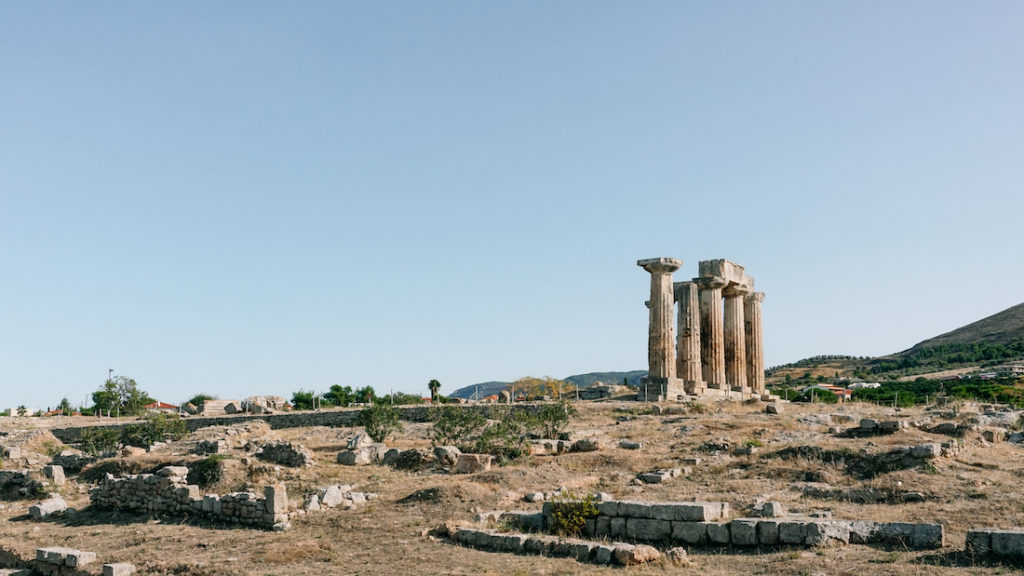
Ancient Corinth was captured by the Romans in 146 BC. The Romans, under Lucius Mummius, killed the men of Corinth and sold the women and children into slavery. After that, they burned the city, and for more than a century, the area remained largely uninhabited.
Corinth was refounded in 44 BC by Julius Caesar shortly before his assassination. It soon became one of southern Greece’s epicenters, inhabited by a mixture of Greeks, Romans, and Jews.
4. What’s the connection between Apostle Paul and Corinth?
The city of Corinth is mentioned several times in the New Testament. Most of these mentions are connected with the Apostle Paul’s presence in the city. It is largely believed that Paul founded the Church of Corinth.
According to historians, Apostle Paul visited Corinth in AD 49 or 50 and stayed there for approximately 18 months. He preached, worked there as a tentmaker together with Priscilla and Aquilla, and later traveled with them. Paul wrote two Epistles to Corinthians, the first one while he was in Ephesus and the second one from Macedonia.
5. Where is Modern Corinth?
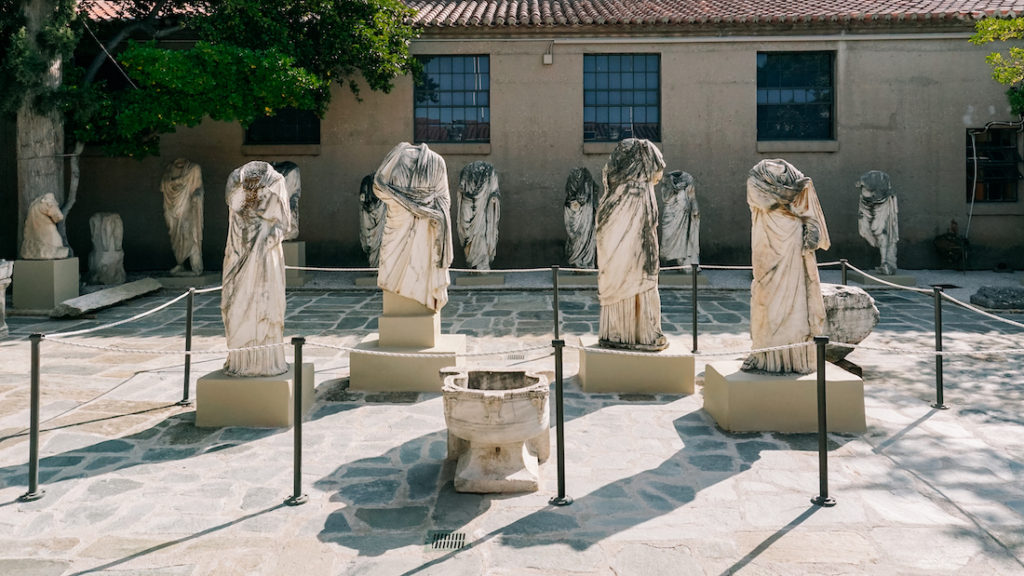
Until 1858, Corinth was located around the ruins of Ancient Corinth. However, in 1858 a major earthquake (6,5 in magnitude) completely destroyed the settlement. It was at this time that modern Corinth was established, approximately 3 km away from the archaeological site. In 1928 a 6,3 magnitude earthquake destroyed the new city, but it was rebuilt in the same area. Corinth had two harbors: Lechaeum on the Corinthian Gulf and Cenchreae on the Saronic Gulf.
Today, Corinth has approximately 40,000 inhabitants, and it’s a nice city by the sea. It’s definitely a place to stop after you tour Ancient Corinth. It doesn’t come as a surprise that the city of Corinth and Syracuse in Sicily are twin cities.
6. Does Acrocorinth and Ancient Corinth refer to the same place?
No. Acrocorinth is actually the acropolis of Ancient Corinth. It lies a few kilometers away from the ancient city, and it’s a monolithic rock inhabited for millennia until the 19th century. I also wrote an extensive travel guide to Acrocorith, where you can find loads of info for your visit. If you happen to be in the area, you shouldn’t miss the chance to visit Acrocorinth.
7. Did Ancient Corinth have prostitutes?
Yes, it did. In classical times, Corinth had a temple dedicated to Aphrodite, the goddess of love. During this time, the temple employed thousands of hetairas (temple prostitutes), Lais being the most famous of all. The hetairas served mainly wealthy citizens, merchants, and state officials.
The temple prostitutes were highly educated, and apart from the sexual services, they acted also as artists and entertainers. They charged very high prices, and thus, the quote of the era: “The journey to Corinth is not for every man.”
8. What were the Isthmian Games?
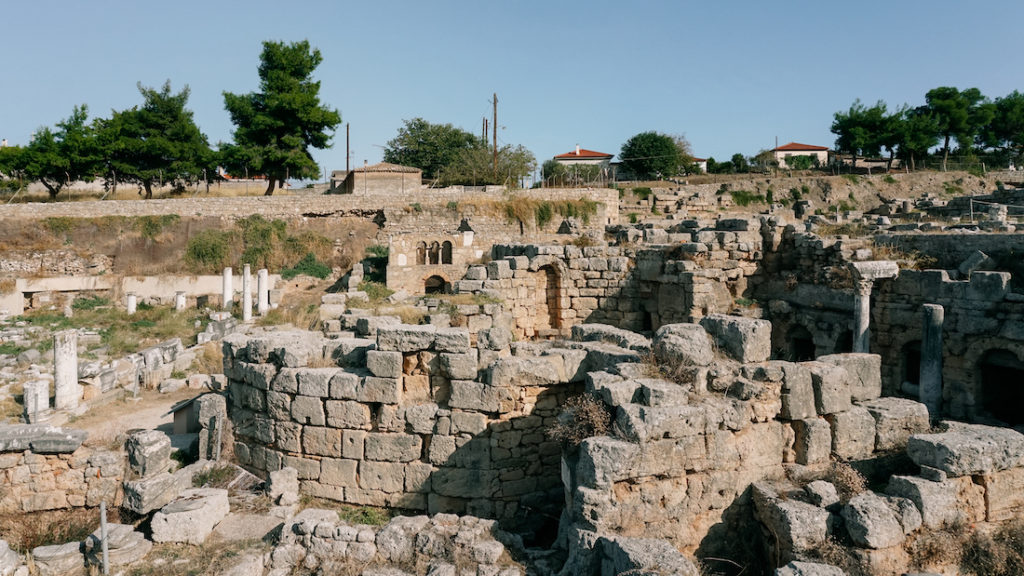
The Isthmian Games, or simply Isthmian, were one of the four Panhellenic Games of Ancient Greece. The name derives from the Isthmus of Corinth, and the Games took place for the first time in 582 BC. According to historians, the Games were actually funeral games in memory of Melicertes.
Melicertes (later known as Palaemon) was the son of Athamas and Ino. In order to escape from her husband, Ino jumped into the sea together with her son. A dolphin carried the dead body of young Melicertes to the Isthmus of Corinth. His uncle Sisyphus found the body of Melicertes under a pine tree. Then, the Nereids commanded him to make sacrifices to honor Melicertes’ memory, and that’s how the Isthmian Games started.
Exactly like the Nemean Games, the Isthmian took place a year before and a year after the Olympic Games. Women were only allowed to compete in music and poetry contests. On the other hand, men could also compete in sports like Pankration, Wrestling, and Boxing. One of the highlights of the Isthmian games was definitely the achievement of Kleitomachos, one of the most legendary athletes of the era. In 216 BC, he won boxing, wrestling, and pankration on the same day.
9. What’s special about the Temple of Apollo in Ancient Corinth?
The temple of Apollo at Corinth is one of the earliest Doric temples in the Peloponnese region. It was erected around 560 BC, and local limestone was used. The temple of Apollo was peripteral, and it had 42 monolithic columns, of which only 7 are still in place. Each of the columns is 7 meters high. The central structure is split into three distinct parts: an antechamber with two columns in antis (pronaos), a central rectangular room subdivided into two parts (cella), and a back room with two columns (opisthodomos).
10. What is the Corinthian order, and how it’s different from the Doric and Ionic?
The Corinthian order (or Corinthian capital) was developed in Ancient Corinth, and it’s the third style of classical architecture. The Corinthian order was the most luxurious of the three and the most complicated one too. It is assumed that it’s proof of the city’s wealth and lifestyle. On the other hand, the Doric order showcased the Spartans’ simplicity, and the Ionic showed the balance between the two.
The Corinthian order is often assumed to be the most elegant of the three Greek orders. According to Vitruvius, Callimachus created the Corinthian order, inspired by a basket full of toys next to the grave of a young girl. The main characteristic of the Corinthian column is an ornate capital carved with acanthus leaves. The Corinthian columns also have the tallest bases (in comparison to the Doric and Ionic ones).
What you can see in the archaeological site of Ancient Corinth
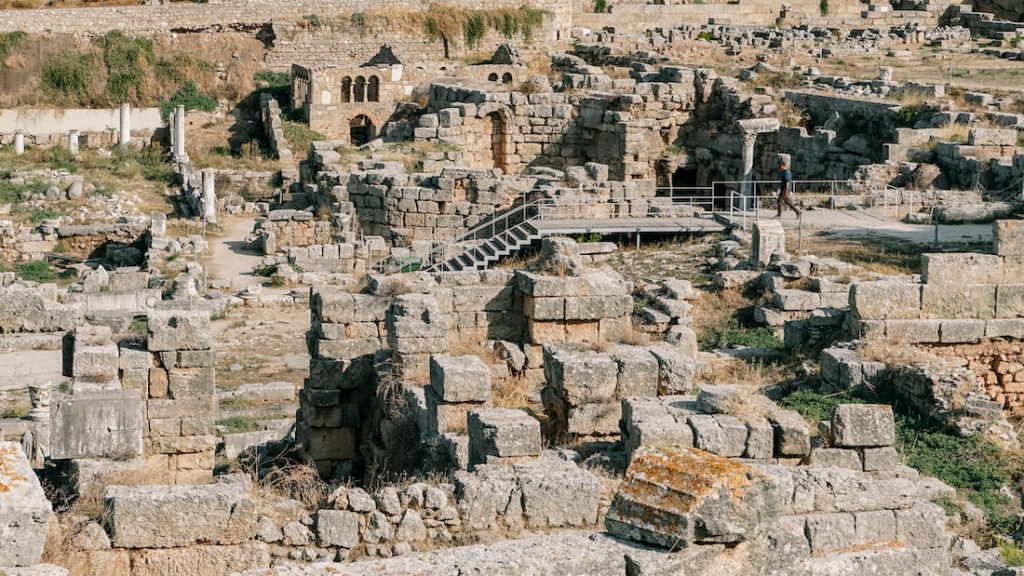
As I wrote in the introduction, I was amazed both by the preservation and the plethora of monuments in the ancient city. Even though the city was destroyed multiple times and suffered a lot -in the Peloponnesian War (431-404 BC), Corinth openly allied with Sparta- Ancient Corinth managed to survive. The Corinth Excavations were carried by the American School of Classical Studies at Athens and revealed secrets and ancient history stories. The excavations helped to understand ancient Greek history better -and the ancient times marked world history in total.
There are plenty of things to see in Ancient Corinth’s archaeological site, and here are some of the highlights.
- The world-famous Temple of Apollo. Built around 560 BCE, the temple is the absolute emblem of the ancient city.
- The Lechaion Road. It linked the Agora of Corinth with the harbor of Lechaion on the Corinthian gulf. The distance it covered was approximately 3 kilometers to the north.
- The Propylaia. That’s the main entrance to the Forum.
- Heroon of the Crossroads. A hero shrine is located at an intersection.
- The Peirene Fountain. It owes its name to the nymph Peirini.
- Captive’s Facade. It -probably- commemorates the victories of Emperor Septimius Severus over the Parthians in 197 AD.
- The Odeon. It could accommodate an audience of 3,000 people.
Here you can find a detailed ground plan of the archaeological site.
Where to stay in Ancient Corinth
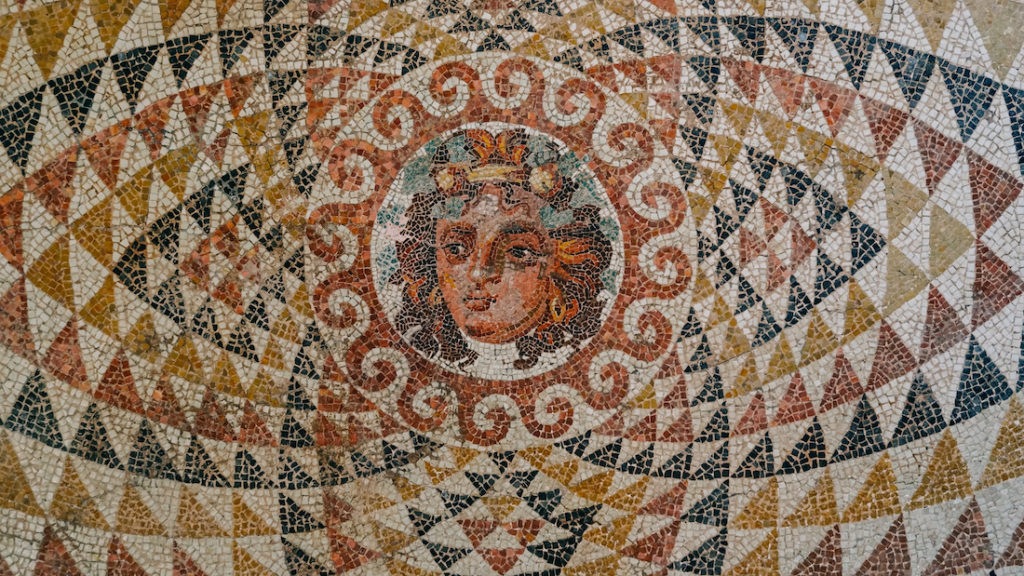
Most of your accommodation options in Ancient Corinth won’t be straight at the archaeological site. Corinth’s modern city is just a couple of kilometers away, and it’s a more lively area with lots of hotels. So, here’s where you can spend the night in or around Ancient Corinth.
Maria’s Boutique rooms. A wonderful option in Ancient Corinth, not far away from every place of interest in the region. Check the availability of Maria’s Boutique Rooms here.
Lavish Villa with swimming pool. This is a wonderful option if you are traveling with friends or can afford the cost. This beautiful villa is close to everything, and it comes with a swimming pool. Check the prices for the Lavish Villa here.
Petra Luxury Apartments. One more excellent option for your accommodation. The apartments are in modern Corinth, and their prices are really moderate. See the Petra Luxury Apartments here.
Ancient Corinth Guesthouse. That’s one of the most affordable options in the area. The rooms are clean and the prices low. If you’re on a tight budget, that’s probably the ideal option for your stay. Check the Ancient Corinth Guesthouse here.
Practical info for your visit
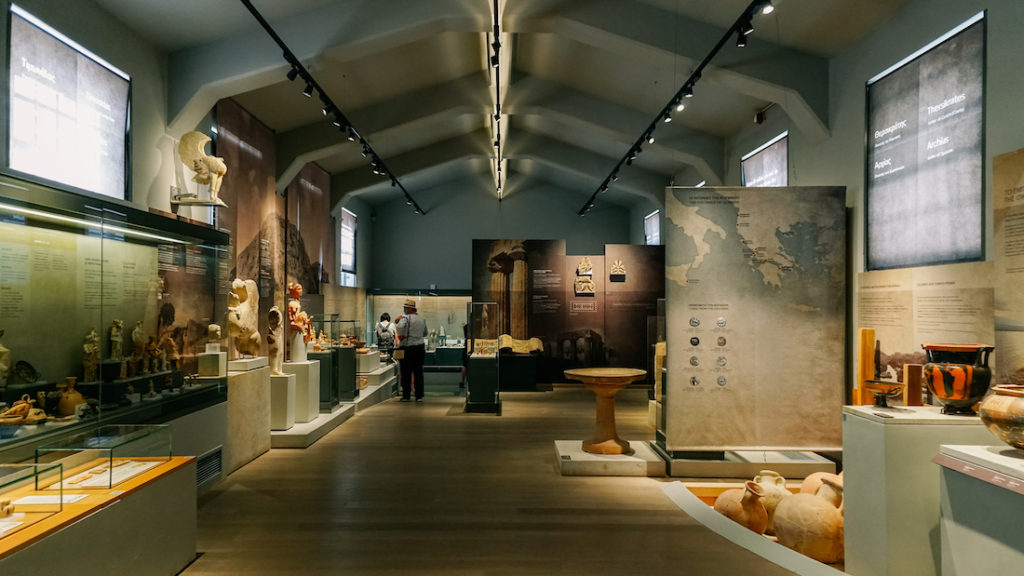
Here you can find further info for your visit to Ancient Corinth. While I always update my tour guides, I will also link to the official websites. Feel free to check them out in case something changes at short notice.
Opening times
The opening times for both the museum and the archaeological site of Ancient Corinth differ depending on the time of the year. That said, check the schedule before visiting. Currently, the opening times are:
Winter
From November 1st to December 31st:
8:30-15:30, open daily.
Summer
Until August 31st: 8:00-20:00, open daily.
1st to 15th of September: 8:00-19:30
September 16th to September 30th: 8:00-19:00
1st to 15th of October: 8:00-18:30
16th to 31st October: 8:00-18:00
For more up-to-date information, please check here.
For further information about the museum, you can also visit the official website of the local Archaeological Museum.
Admission fees
The full ticket costs 8 euros, while the reduced one costs 4 euros. The price includes your visit both to the Museum and the archaeological site.
Organized tours to Ancient Corinth and beyond

While in my opinion, the best way to discover Ancient Corinth is definitely by car, I know that some of you would prefer an organized tour instead. Most of these day trips to Ancient Corinth start from Athens, and a driver will pick you up from your accommodation. Having a tour guide is always a nice plus, and the guys will also bring you back to your hotel. Most of the day trips to Ancient Corinth will require one full day, and you will probably visit a couple of other places, too.
So, here you can see the best guided tours to Ancient Corinth. These are:
Athens and Corinth full-day tour. On this tour, you will visit the Acropolis of Athens, and then you will head over to Ancient Corinth. If you want to see two of the most important antiquity spots, that’s your best option. See prices and availability here.
Corinth Canal, Ancient Corinth, Mycenae, and Nafplion. This is a private day tour for people interested in seeing everything that Ancient Greece has to offer. After crossing the Corinth Canal, you will visit Ancient Corinth, and then you’ll head over to Mycenae. Before returning to Athens, you will stop at the beautiful coastal city of Nafplion, which once served as Greece’s first capital and home to Palamidi Castle. If you can afford this tour and you’re interested in Greek antiquity, don’t miss it. Check out the prices and availability here.
Half-day tour from Athens to Ancient Corinth. That’s the perfect tour for people on a tight budget. This half-day tour will take you to Ancient Corinth, where you’ll visit the archaeological site, and then you’ll return to Athens. Check it out here.
What else can I see in the region?
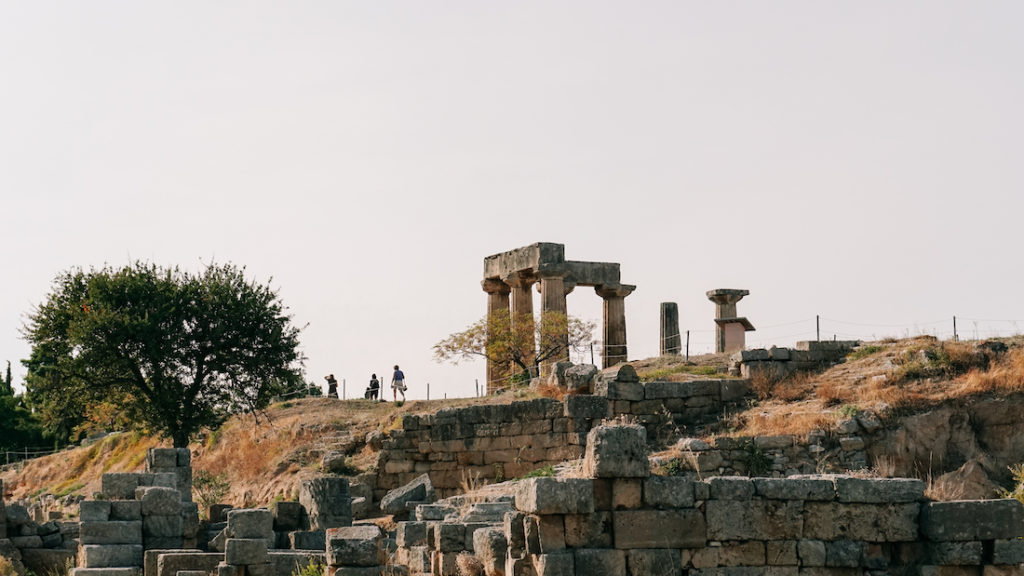
Peloponnese is a beautiful region rich in history. If you are about to take a road trip to the Peloponnese and have a thing for Ancient Greece, you will find plenty of antiquity spots. I wrote some extensive travel guides to places of interest in the Peloponnese, and I’m linking to them below.
However, it will probably be tough to combine all these places in one day. Therefore, I suggest that you book accommodation in the region (check my recommendations above) and take a slow tour of one of mainland Greece’s most beautiful areas.
More specifically, you can find guides to:
- Mycenae, the gem of Ancient Greece.
- Acrocorinth, the acropolis of Corinth.
- Nemea, a region rich in history and the homeland of Greek wine.
- Bonus: The most comprehensive tour guide you’ll find online for a one-week vacation in Greece (islands+mainland).
A visit to Ancient Corinth: Final thoughts
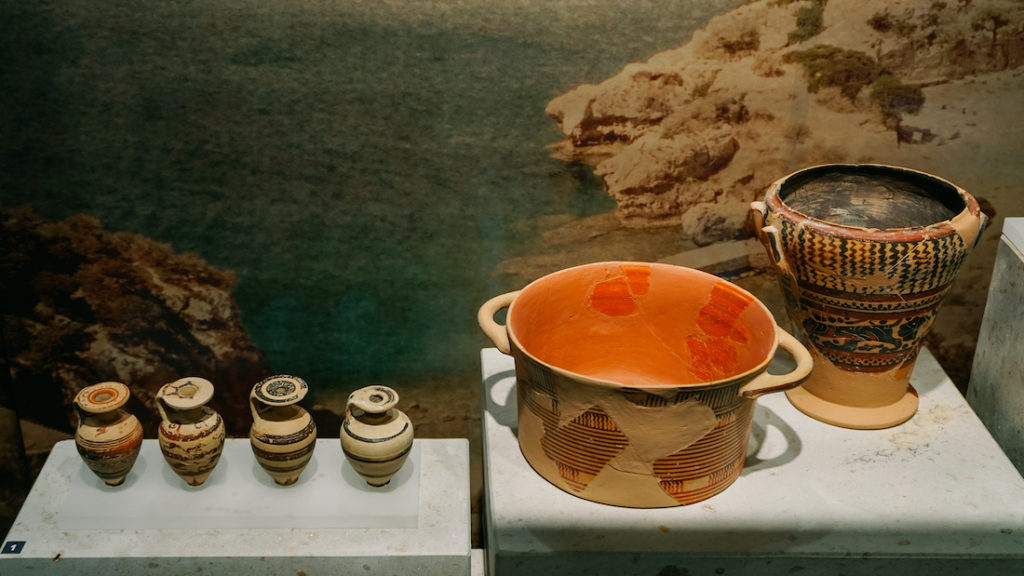
Even though I come from Greece, I only recently discovered the beauty of Ancient Corinth. Most visitors choose to visit Mycenae, which is obviously the most legendary spot of Greek antiquity. However, I can only recommend a visit to Ancient Corinth and Acrocorinth. The reason is that you will get a better idea about Ancient Greece and you will also discover the lesser-known areas of antiquity.
Therefore, if you are on a road trip to the Peloponnese -or if you simply have a thing for Greek antiquity- make sure to include Ancient Corinth in your itinerary. Together with Mycenae and Nemea, these are some of the most legendary spots of Ancient Greece.
More guides about Greece: Greek islands on a budget, Greek ferries guide, Domestic flights in Greece
Pin it for later
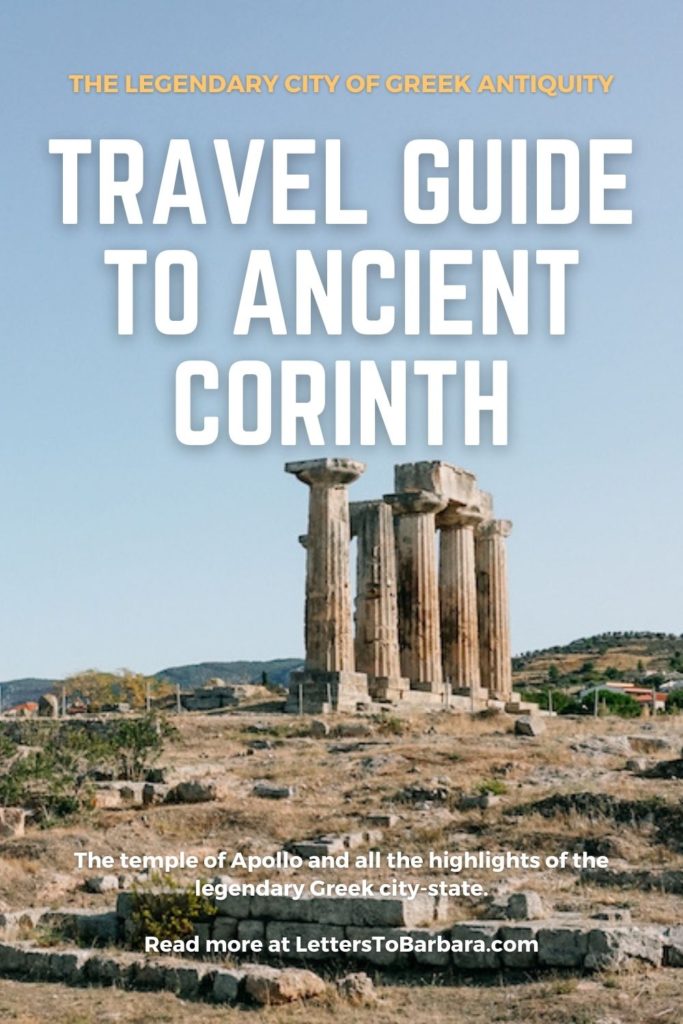
Did you enjoy this Ancient Corinth guide? Feel free to share it with your friends on Facebook, Twitter, or Pinterest.
Last Updated on April 15, 2024 by George Pavlopoulos

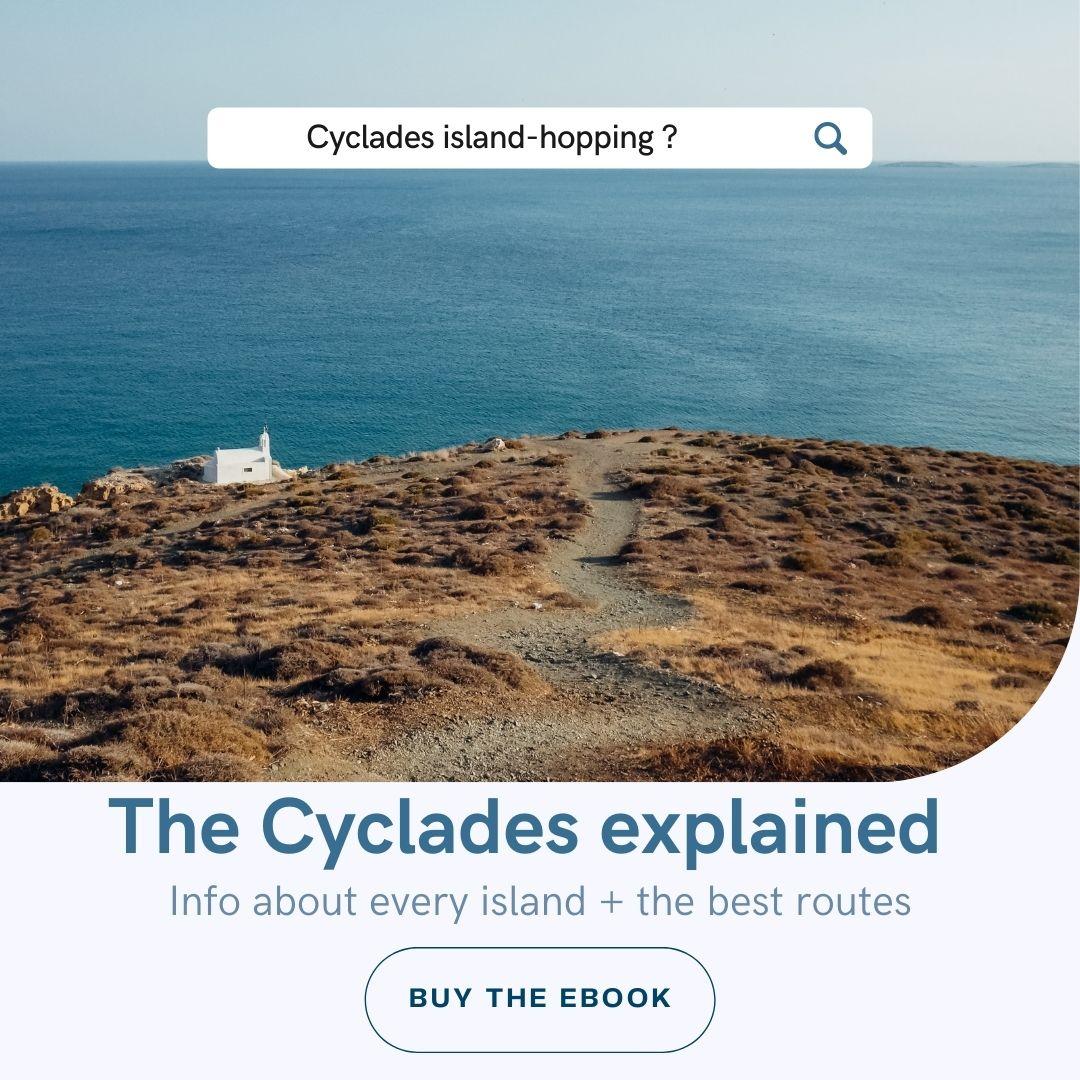
Hi George, since you’re Greek, it would undoubtedly give you an inner perception of other Greeks living in different parts of Greece. I wonder what your impression of someone you met would be who said they’re from Corinth? Does it invoke any thoughts or feelings, such as high esteem or pity? Is it rare to meet such a person? Do they have any traits you admire? Is Corinth a good place to live?
Hey John,
Modern Corinth is a proper -even small- city; therefore, its population is more or less the same as everywhere else in Greece. I didn’t spot any huge differences, to be honest, and I wouldn’t say that it invoked feelings of any kind. I think that if you want to spot some local flair, accent, or attitude, I’d say that you have to visit smaller, more rural areas. But I would say that in general, the urban areas are homogenized nowadays. Originality can only be found in small places/villages that have less influence from modern habits.
I’d say that modern Corinth is one of these coastal, sunny cities that one can enjoy living in. I’m more of a big city guy; therefore, I wouldn’t consider living there. But this is not because of Corinth itself; it’s because I like noises, voices, pollution, cinemas, festivals, football games, etc. But that’s just me. If, for example, somebody enjoys the slow rhythms of a 40,000 inhabitants coastal city, where you have proximity to different beaches and lots of antiquity spots, then Corinth might be a good idea. Add on top of that the privilege Corinth has: it’s just an hour away from Athens, and you have an attractive option.
Ancient Corinth is just a small village. It is rich in history, but it’s too rural for me. The locals are very friendly, though, and that’s definitely a plus. Do you consider moving to Greece, John? Given that you live in Australia, I think that Peloponnese might be a good option for you -nice weather, lots of things to see, plus insane material for your blog.
I want to live in Greece one day, even if it is only for a year, so I’m scouting around for some interesting places to base myself on the mainland, as well as a Greek Island. Deciding on a suitable base isn’t easy since there are so many great places in Greece. I may have to move around every few weeks.
Well, moving around every few weeks might tire you after a while. Greece has many nice coastal towns, so it’s all a matter of preference. Crete is an excellent option because it has big cities, variety, food, and landscapes. Let alone the history of the place. The Peloponnese is beautiful as well, and the proximity to Athens is always a big plus.
On the other hand, there so many islands that it’s hard to choose one. I think I couldn’t live permanently on a Greek island unless if I had a circle of friends there; winters can be tough, and you might feel lonely. It’ll take time to integrate and be part of the local community.
I can’t really tell you what I’d really do if I were to move permanently to Greece. I guess I’d choose one of the two big cities, Athens and Thessaloniki. If I were to skip these two for whatever reasons, I guess I’d pick Chania: it’s beautiful, it has enough things to do to carry you through the winter, and you can visit different places whenever you want. Crete is a gem -and the summer lasts for months. After living for more than a decade in Berlin, I don’t underestimate the weather’s impact on my mood.
Yes, Crete is on my radar big time. I have only spent half an hour or so on Crete while on a Greek island cruise. It left a big impression on me even though all I remember is a Greek lady asking me something at a fountain close to where the ship docked, as well as a city street that mesmerized me. Everyone I have asked, be that taxi drivers or hotel staff, have told me that Crete is one of the best Greek islands.
When I stayed in Santorini, the hotel lady was from Crete, and she was so friendly. I think she was a bit homesick. She told me that the food is delicious over there. The beaches look incredible. Now that you also mention Crete is a great Greek island, I will have to return for my second visit. Walking the Samaria Gorge has also been on my bucket list for quite a while. Have to do it one day.
Crete is an amazing place. The food is delicious, I liked the locals a lot and if you want to swim all year long, look no further. The fact that you can have such a landscape variety -from tall mountains to marvelous beaches- makes it an unbeatable option. Plus, it has some decent nightlife (bars, clubs, cinemas, etc.) to help you survive the winter. I’d say that if you can stand the summer crowds (August can be overwhelming), it’s one of the finest places in Europe to spend a year or two. You know already that I love tiny, remote islands, but Crete is a whole different category.